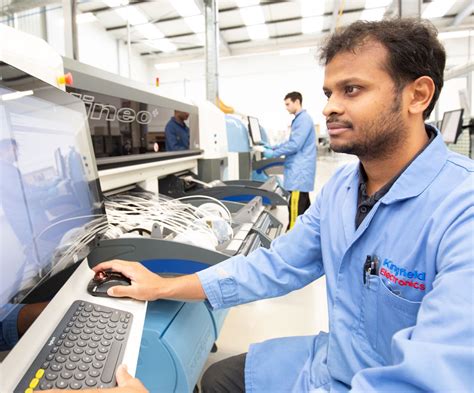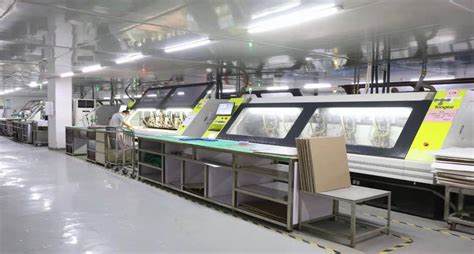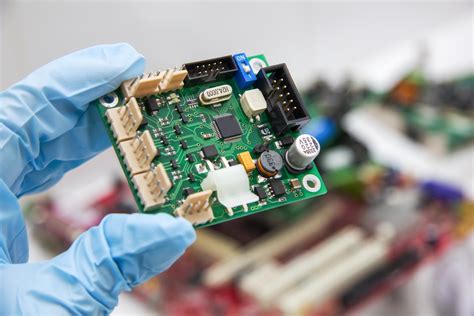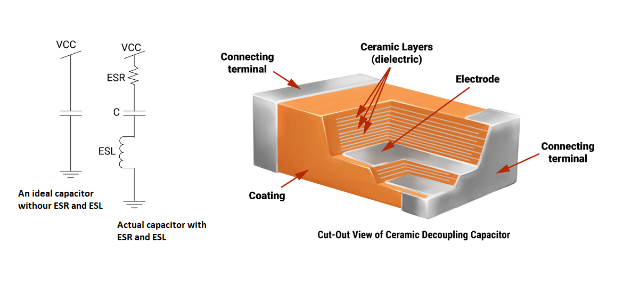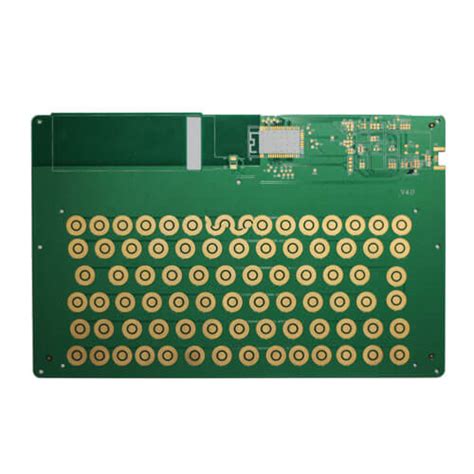Unlocking Efficiency: The Future of Contract Manufacturing in PCB Assembly
Key Takeaways
In the dynamic world of electronics, contract manufacturing in PCB assembly (often referred to as PCBA) has emerged as a pivotal approach to meeting industry demands. With the relentless pace of technological advancement, manufacturers are increasingly turning to specialized partners who bring not only expertise but also innovative solutions to the table. The collaboration between companies and contract manufacturers can significantly enhance operational efficiency by leveraging advanced techniques such as automated assembly, surface mount technology (SMT), and sophisticated testing methods that assure high quality in every batch produced. Moreover, this strategy allows businesses to focus on their core competencies while reducing costs and time-to-market for new products. As the demand for electronics rises across various sectors, understanding and embracing these benefits becomes crucial for companies aiming to stay competitive. Overall, insights derived from trends in PCBA practices can guide organizations in making informed decisions about their manufacturing strategies, which ultimately drives success in a fast-evolving landscape.
Introduction to Contract Manufacturing in PCB Assembly
In the fast-evolving world of electronics, contract manufacturing in PCB assembly has emerged as a pivotal solution for companies seeking to optimize production while maintaining high quality and innovation. This approach allows businesses to leverage the expertise and specialized capabilities of dedicated manufacturers, resulting in enhanced efficiency and reduced time-to-market. The pcb assembly process involves intricate steps, including component placement, soldering, and testing, which are often better managed by experienced contract manufacturers due to their access to advanced technologies and economies of scale. For many firms, outsourcing PCB assembly—often referred to as PCBA—not only mitigates risks associated with production but also allocates resources more strategically towards core competencies such as design and development. As we delve into this topic, it becomes clear that the synergy between companies and their contract manufacturing partners is essential for driving innovation in the electronics sector, making it imperative for business leaders to consider how these collaborations can shape the future of their operations.
The Rise of Contract Manufacturing: Key Drivers and Trends
The landscape of pcb assembly is undergoing a significant transformation, driven by various factors that underscore the growing importance of contract manufacturing in this sector. One key driver is the increasing demand for advanced technological solutions that are not only efficient but also cost-effective. As companies strive to meet the rapid pace of technological innovation, contract manufacturers provide valuable expertise and resources, often allowing for faster production cycles and superior product quality. Furthermore, the rise of global supply chains has enabled businesses to access a broader range of materials and technologies, enhancing their capabilities in pcb assembly. This shift is complemented by the need for flexibility in production, as companies seek to adapt to changing market demands without incurring excessive overhead costs. Additionally, trends such as miniaturization and the integration of complex electronics are pushing manufacturers to adopt advanced production techniques that improve accuracy and efficiency in pcba processes. As a result, organizations are increasingly recognizing the strategic advantages of partnering with seasoned contract manufacturers who can effectively address these evolving challenges.
Innovations in PCB Assembly Technology
The field of pcb assembly is experiencing transformative advancements that are redefining manufacturing processes and enhancing operational efficiency. One significant innovation in pcba technology is the utilization of automated assembly techniques, which drastically reduce assembly time and minimize human error. These techniques employ sophisticated machinery and robotics to ensure precision, allowing for increased production rates while maintaining high quality. Additionally, the integration of smart manufacturing principles, such as the Internet of Things (IoT), helps in real-time monitoring and data analysis, which can identify bottlenecks in the production line instantly.
Another notable advancement is the adoption of additive manufacturing within the pcb assembly process. This enables manufacturers to create complex geometries that were previously unattainable with conventional methods, fostering innovation in design and functionality. Moreover, advancements in component miniaturization are leading to denser circuitry designs, optimizing space utilization on printed circuit boards and enabling more features within smaller devices.
Sustainability has also become a pivotal focus in modern PCB assembly technology. Manufacturers are now exploring eco-friendly materials and processes that reduce waste and energy consumption. The move towards lead-free components reflects a broader commitment to environmental stewardship within the industry.
In summary, innovations such as automated systems, smart manufacturing integration, additive techniques, and sustainable practices are shaping the future landscape of pcba technology. These developments not only enhance efficiency but also drive greater innovation across various sectors reliant on advanced electronics.
Benefits of Partnering with Contract Manufacturers
Partnering with contract manufacturers for PCB assembly offers numerous advantages that can significantly enhance production capabilities. First and foremost, leveraging the expertise of specialized contract manufacturers enables companies to access advanced technologies and processes that they may not possess in-house. This can lead to improved quality and consistency in the printed circuit board assemblies (PCBA), which are crucial for meeting stringent industry standards. Additionally, contract manufacturing offers flexibility in scaling production, allowing businesses to adapt quickly to changing market demands without the burden of substantial capital investment in machinery and labor.
Moreover, engaging with contract manufacturers can also streamline supply chain management. By outsourcing PCB assembly, companies can reduce lead times and optimize inventory levels, ultimately leading to enhanced efficiency. The collaboration often results in cost savings as well; manufacturers who handle large volumes usually have better purchasing power for components, resulting in competitive pricing.
“Outsourcing non-core functions like PCB assembly allows a company to focus on its primary business strategies while leveraging external expertise.” In essence, the synergy between businesses and contract manufacturers can drive innovation and output while fostering a more dynamic response to customer needs. The inherent advantages make this partnership a valuable strategy in today’s fast-paced technological landscape.
Challenges in PCB Assembly and How to Overcome Them
In the rapidly evolving landscape of pcb assembly, manufacturers face numerous challenges that can impede efficiency and compromise quality. One significant hurdle is the complexity of design specifications, which can lead to difficulties during the pcba process. As electronic devices become more sophisticated, ensuring that all components integrate seamlessly requires substantial expertise. Additionally, supply chain disruptions and component shortages are persistent issues that can cause delays, impacting production timelines.
To overcome these obstacles, companies are increasingly turning to contract manufacturers who specialize in pcb assembly. These partners bring valuable insights and advanced capabilities to optimize production workflows. By leveraging state-of-the-art technology and manufacturing techniques, contract manufacturers can streamline processes and minimize errors, thereby enhancing overall efficiency. Adopting flexible manufacturing strategies also allows for quicker adjustments to changing market demands or component availability.
Furthermore, investing in workforce training ensures that employees are well-equipped to handle unique design challenges while adhering to the latest industry standards. Collaborative communication between design teams and contract manufacturers fosters a more agile production environment, allowing stakeholders to address potential issues before they escalate into larger problems. By tackling these challenges head-on through strategic partnerships and innovation in manufacturing practices, businesses can ensure a more resilient pcb assembly process that meets evolving technological demands.
Future Trends Shaping the PCB Assembly Landscape
The landscape of PCB assembly is constantly evolving, driven by various trends that embrace innovation and efficiency. One notable trend is the integration of smart technologies into pcba processes. With advancements in automation and artificial intelligence, manufacturers are increasingly using intelligent systems to enhance quality control and production speed. For instance, machine learning algorithms can predict potential defects during the pcb assembly process, allowing for real-time adjustments that minimize waste and optimize performance.
Additionally, sustainability has become a significant focus. Companies are seeking to implement eco-friendly practices that reduce their carbon footprint while maintaining high standards in pcb assembly. This includes utilizing green materials and optimizing energy consumption during production.
Moreover, the rise of the Internet of Things (IoT) is reshaping how manufacturers operate. By leveraging IoT technology, businesses can gather extensive data throughout their supply chain and production lines. This connectivity leads to improved transparency and operational efficiency—key factors in meeting demanding market needs.
To illustrate these trends effectively, the table below outlines key future trends within the pcb assembly industry:
| Trend | Description |
|---|---|
| Smart Technologies | Use of AI and automation to enhance efficiency |
| Sustainability | Implementation of eco-friendly materials and practices |
| IoT Integration | Enhanced connectivity for transparency and data collection |
| Customization | Increased demand for tailored solutions in PCB designs |
As these developments continue to unfold, it is clear that adaptability will be crucial for manufacturers aiming to thrive in a competitive landscape. Companies must embrace these trends not only to enhance their operational capabilities but also to meet the ever-evolving expectations of their clients in the realm of pcba.
Case Studies: Successful Contract Manufacturing Examples
The landscape of PCB assembly has been greatly shaped by numerous case studies that showcase the impact of contract manufacturing in driving efficiency and innovation. For instance, a well-known technology company recently partnered with a contract manufacturer to streamline its PCBA process. By leveraging advanced automation and optimized production lines, the company was able to reduce its production cycle time by 35%, all while maintaining high-quality standards. Such transformations illustrate how collaboration with skilled manufacturers can enhance both speed and efficacy in the pcb assembly process. Another compelling example involves an emerging startup that focused on developing a revolutionary medical device. By outsourcing its assembly to a reputable contract manufacturer, it benefitted from expert knowledge in regulatory compliance and specialized equipment, which significantly accelerated its product launch timeline. These success stories underline the strategic advantages of engaging with contract manufacturers, which not only bolster operational capabilities but also pave the way for companies to focus on their core competencies and drive innovation in their product offerings. With these examples in mind, it’s clear that choosing the right partner in PCB assembly can yield remarkable outcomes, ultimately influencing a company’s trajectory in an increasingly competitive technological landscape.
Conclusion: Embracing Change in the PCB Assembly Industry
As we navigate the rapidly evolving landscape of pcb assembly, it is evident that embracing change is no longer optional but essential for success. The advent of contract manufacturing in this sector signifies a pivotal shift towards enhanced efficiency and productivity. Companies that engage with expert partners in pcba can leverage innovative techniques and state-of-the-art technologies, enabling them to streamline their processes and reduce time to market. Moreover, the collaboration with contract manufacturers allows businesses to focus on their core competencies while benefiting from specialized knowledge in assembly operations. This strategic partnership not only facilitates quicker adaptation to market demands but also enhances sustainability practices by optimizing resource utilization. Moving forward, it is imperative for players within the pcb assembly industry to remain vigilant and responsive to these transformative trends, as they hold the key to unlocking competitive advantages and driving long-term growth. In this era of rapid change, those who adapt effectively are poised to thrive amid challenges, positioning themselves as leaders in a dynamic marketplace.
Conclusion: Embracing Change in the PCB Assembly Industry
In the rapidly evolving landscape of pcb assembly, companies are increasingly turning to contract manufacturing as a catalyst for growth and innovation. The advantages of partnering with contract manufacturers in pcba are immense, including not only cost-efficiency but also enhanced flexibility and scalability. With the integration of cutting-edge technologies and innovative processes, these manufacturers are positioned to meet the ever-changing demands of the market. Moreover, as industries face increasing pressures for quicker turnaround times without compromising on quality, the adoption of contract manufacturing in PCB assembly becomes essential. By leveraging expertise from established players in the field, businesses can focus on their core activities while still pushing forward with advanced solutions. However, it is crucial to remain aware of the challenges that may arise during this transition. Continuous evaluation and adaptation will ensure that companies not only keep pace with industry standards but also thrive in this dynamic environment. Embracing these changes is key to unlocking new dimensions in pcb assembly, paving the way for a more efficient and innovative future.
FAQs
What is contract manufacturing in PCB assembly?
Contract manufacturing in PCB assembly involves outsourcing the production of printed circuit boards (PCBA) to specialized manufacturers. This allows companies to leverage external expertise and resources, streamlining the production process and enhancing product quality.
What are the benefits of using contract manufacturers for PCBA?
Partnering with contract manufacturers for PCBA offers numerous benefits, including reduced manufacturing costs, shorter production timelines, and access to advanced technology and skilled labor. This collaboration facilitates a focus on core business functions, such as product design and market strategy.
How does technology impact PCB assembly?
Innovations in technology have revolutionized PCB assembly, making processes faster and more efficient. Techniques such as automated assembly lines, advanced testing methods, and improved materials enhance the quality and reliability of assembled circuit boards, meeting the demands of modern electronics.
What challenges are associated with contract manufacturing in PCB assembly?
While there are significant advantages to contract manufacturing, challenges such as maintaining quality control, communication issues, and logistical complexities can arise. Establishing clear communication channels and setting stringent quality standards are essential to overcoming these obstacles.
What future trends should we expect in PCB assembly?
The future of PCB assembly is shaped by trends like increased automation, the integration of artificial intelligence for quality assurance, and a growing emphasis on sustainability. These developments promise to enhance efficiency while addressing environmental considerations in manufacturing processes.

